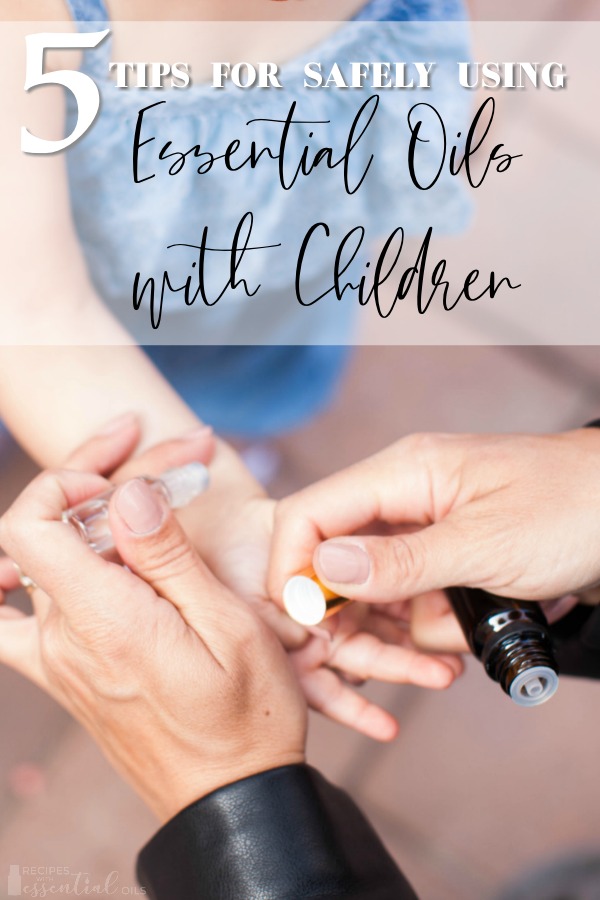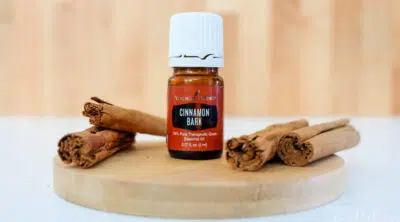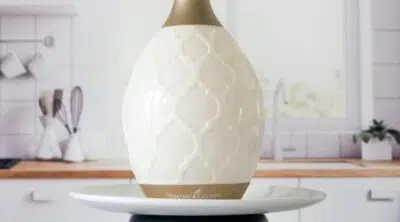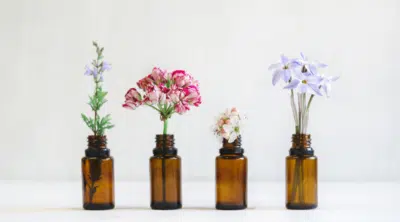We use essential oils in our home every day. Our kids get in on the fun and they even have their own favorite blends! It’s important to remember that essential oils are quite potent and children are more sensitive to some essential oil components than adults. So, we’ve put together a few tips to help guide you in safely using essential oils with your children.
It’s important to remember that essential oils are quite potent and children are more sensitive to some essential oil components than adults.
Use this guide to help you in safely using essential oils with children:
Tip #1: Oils to Avoid around Young Children
When enjoying essential oils with the entire family, there are a few essential oils that should never be used around infants and very small children. Avoid diffusing these oils around children and do not use them topically or internally for young ones.
- Blue Tansy
- Clary Sage
- Eucalyptus
- Hyssop
- Idaho Tansy
- Peppermint
- Sage
- Wintergreen
This is not an exhaustive list, but a starting point of oils you should strongly investigate before introducing to your children.
Tip #2: Dilution is Key
For topical essential oils, dilution recommendations are always listed on the label. Using oils with children will require additional dilution with quality carrier oils.
Here are some guidelines that may help:
- For babies (age 0 – 1), increase the recommended carrier oil by 8 times. So if the dilution on the label calls for 1 drop to be diluted in 1 teaspoon of carrier oil then for babies you would dilute 1 drop of essential oil in 8 teaspoons of carrier oil. If there is no dilution ratio on the label, then dilute 1 drop of essential oil with at least 1 tablespoon of carrier oil.
- For toddlers and young children (age 2 – 6), increase the recommended carrier oil by 4 times. For example, if the recommended labeled dilution is 1 drop of essential oil per 1 teaspoon of carrier oil, then you would dilute 1 drop of essential oil in 4 teaspoons of carrier oil. If no dilution is listed on the label, then dilute 1 drop of essential oil with 1 1/2 teaspoons of carrier oil.
- For elementary children (ages 7 – 11), increase the recommended carrier oil by 2 times. For example, if the label recommends diluting 1 drop of essential oil with 1 teaspoon of carrier oil, then increase the carrier oil to 2 teaspoons per 1 drop of essential oil. If no dilution is listed on the label, then dilute 1 drop of essential oil with at least 1 teaspoon of carrier oil.
Tips #3: Test for Sensitivities
All people react differently to essential oils. But, I do have to admit that when I get a new oil, I just jump right in there and use it on myself without testing for sensitivity. I DO NOT do that with my kids though! Test new oils on children by applying properly diluted essential oils to the arm or leg and watching closely for a reaction. When in doubt, wait until your child is older to introduce essential oils topically.
Tip #4: Diffuse Less Oils
We love our diffuser and use it all the time. However, children are definitely more sensitive to essential oils than adults. So, we diffuse fewer drops of essential oils in our common areas and save our stronger blends for the adult bedroom and/or bathroom.
Tip #5: Safe Use of Essential Oil Recipes
Most of our recipes on RecipeswithEssentialOils.com are written exclusively for adult use and we want to be sure to use caution with children in the home. For instance, you might love our sore muscle bath soak, but you’ll want to make sure to keep essential oils out of your child’s bath. If they splash and get essential oils in their eyes, it definitely won’t be a peaceful bath!
As always, follow proper safe storage guidelines to always keep essential oils out of the reach of children.
Check out our Essential Oil recipes written with children in mind:
- Bedtime Blends for Kids
- Good Night Bedtime Spray
- Hair Detangler Spray
- Soothing After Sun Spray (although be careful on the peppermint for babies)
- Summer Camp Survival Kit





Georgina says
Hi! Thanks for the informative post. Blue Tansy is included in oil blends: Valor and Peace & Calming. Does Blue Tansy makes these oil blends unsafe for 3 year olds? Thanks!
Beth K says
I originally gathered part of this information from an infographic on Young Living’s blog. This was located on a blog post of theirs that I am no longer able to access but here is the graphic.
This information states that blends with Blue Tansy should be avoided with infants. I’d make sure to consult a healthcare professional for personalized guidance for your toddler.
Samantha says
I have read several articles stating to use clary sage on breasts or feet to encourage milk. Your article says to avoid on/near baby. Just curious if it is safe to put on while I plan to breastfeed.
Beth K says
Hey Samantha! Congratulations on your little one! We love babies around here.
I would say that I have never seen a study on WHY to avoid clary sage around babies. We sourced this recommendation about Clary Sage from Young Living. If I personally chose to use clary sage while nursing I would read everything I could to find if the clary sage in my breastmilk is to be avoided or just using the oil around the baby aromatically or topically. We always make recommendations with an abundance of caution and I just don’t know the reasoning behind the recommendation to avoid so I can’t confidently say that I’d even use it on my feet.
I nursed all of my 6 children and so I understand wanting to always make great choices for mother and child during that time. I wish I had a better answer for you. I’d love to know what you find out.
Amy says
I understand that children’s systems are more sensitive, but the articles leave me questioning what about the list of “dangerous” essential oils – such as clary sage, eucalyptus, etc. – makes them hazardous? In what way are they hazardous? What will happen? The articles do not address this.
Beth K says
It has to do with the naturally occurring constituents of each essential oil. Some of the essential oils mentioned are great for adults but can possibly slow breathing in children to a dangerous level. We hope that you will take this list and do your own research on how you will administer the oils in your family.
Emily H says
I’ve been looking for a roller ball blend for bed wetting. I have read cypress is best. How many drops per 10ml roller ball would you use? I’ve seen some recipes for 10-15 drops. That seems like way too much. What’s your opinion?
Thanks
Beth K says
Emily, I am sorry to say that we are not doctors and cannot give any medical advice. I hope that you can contact a healthcare provider that can help you with that issue and possibly point you to a natural treatment. Our best to you on your health journey!